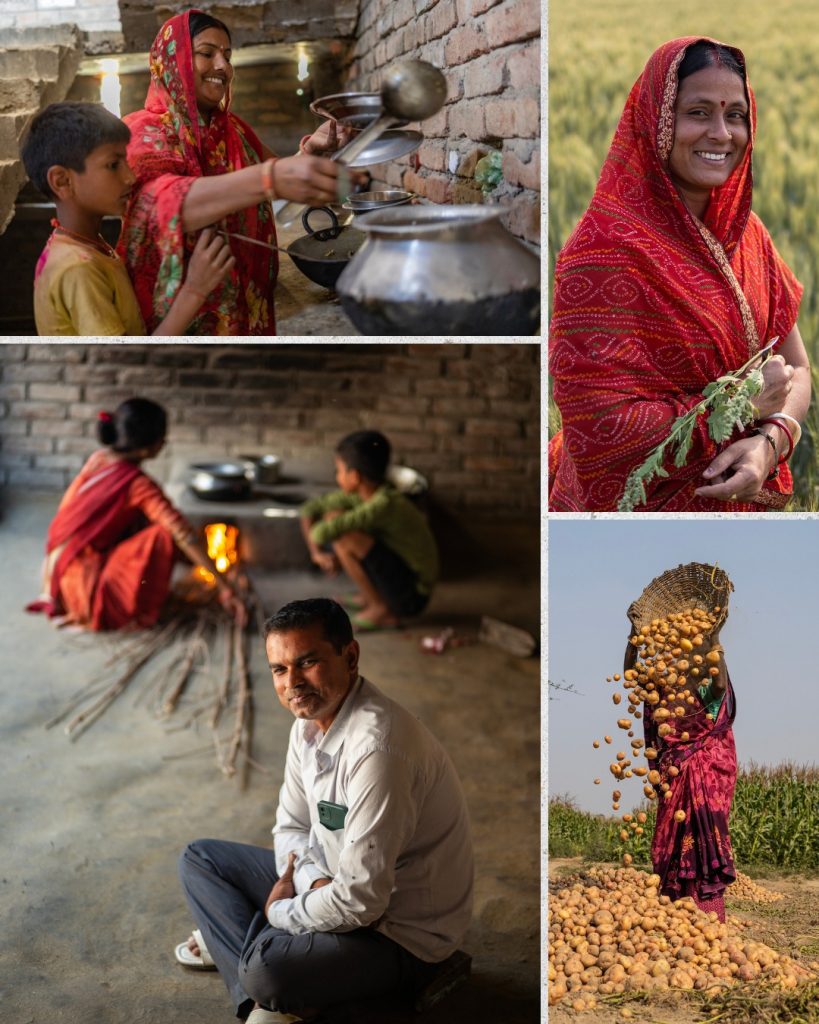Can Climate-Smart Solutions in Agriculture Address Women’s Triple Drudgery?
Exploring how climate-smart solutions can reduce women’s triple burden of household labor, farm work, and caregiving—paving the way for gender-responsive adaptation in agriculture.
By Riya Gupta
Traditional gender roles often assign women the primary responsibility for preparing food and securing water and fuel. Climate-induced challenges, such as erratic rainfall and prolonged droughts, complicate these tasks, forcing women to travel greater distances to find water and firewood. In agriculture, women predominantly engage in labour-intensive activities like planting, weeding, and harvesting. Climate variability increases the unpredictability of these tasks, leading to longer working hours under strenuous conditions. As primary caregivers, women are also expected to manage household duties and childcare, roles that become increasingly demanding during climate-related crises. This cumulative burden leaves little time for rest or personal development, perpetuating cycles of poverty and gender inequality.
Implementing Climate-Smart Agriculture (CSA) offers promising avenues to reduce women’s labour burdens and enhance their resilience. Technologies and practices under CSA such as Direct-Seeded Rice (DSR), stress-tolerant crop varieties, early planting, zero tillage, and micro or supplementary irrigation have demonstrated potential in this regard. DSR, for instance, which eliminates the need for transplanting (task traditionally performed by women) by sowing seeds directly into the field, has shown the improvement in productivity and a decrease in drudgery for women (Khatri et al. 2020)[i]. In the case of zero tillage, a good uptake is observed amongst women farmers more than males (Adzawla et al. 2019)[ii] as it reduces the physical labour by eliminating the need for traditional ploughing.
With the evidence around the globe suggesting CSA practices and technologies benefitting women, a trend of gendered adoption persists due to regional social exclusion, norms, and practices. Therefore, addressing the intersection of climate change and gender requires a deep understanding of the unique challenges faced by women in agriculture. Fostering the right enabling environment is essential to bridging this gender divide, ensuring that women have the knowledge, resources, and institutional support needed to adopt climate-smart solutions effectively.
Several studies have highlighted a diverse range of enablers to bring a parity in the adoption of CSA practices and technologies. Some key themes evolve around providing incentives to female farmers through supportive institutional policies, enhancing their skills and awareness through field trainings about farming technologies and implements, strengthening their social capital (such as self-help groups and community networks), and ensuring an easy access to different forms of credit and market. Benefits of creating right enabling environment has been highlighted by the researchers. For example, when the community women received proper agricultural training and learned how to manage their family finances, they were able to make the most of solar-powered drip irrigation in the Lombok Island of Indonesia. As a result, their harvests increased by 25%–40% within just one planting season (Siantoro et al. 2023)[iii].
Ensuring equitable resilience also demands modern tools, data-driven decision-making, and targeted interventions that empower vulnerable and marginalized groups—particularly women. In this context, the Atlas of Climate Adaptation in South Asian Agriculture (ACASA), led by BISA, is pioneering South Asia’s first climate adaptation Atlas by assessing climate change impacts on agriculture for both current and future. The project is aiming to map climate-smart technologies and practices with a gender-sensitive lens for both crops and livestock commodities in South Asia. A thorough literature review is being conducted combined with the expert judgment to validate technologies and practices for gender-suitability. A preliminary analysis of the literature shows the relation of CSA technologies and practices with the drudgery reduction for women particularly in relation to DSR, machine transplanted rice, and dual-crop varieties. This is supplemented with discussion around barriers to adoption and importance of credit, market, skilling, awareness, influence of household dynamics, decision-making on the technology adoption to reduce drudgery for women involved in farming.
Scaling such efforts is not just important—it’s necessary. Gender-responsive adaptation options must be integrated into climate strategies to ensure that CSA benefits reach those who need them the most. By reducing the time and physical labor required in agriculture, CSA has the potential to ease women’s triple burden of farm work, household chores, and caregiving. But for this to happen, technologies and practices must be designed and implemented with a gender-sensitive approach. The conversation around climate adaptation cannot ignore women’s realities. It’s time to prioritize solutions that not only improve productivity but also promote equity—because when women thrive, entire communities benefit.
[i] Khatri-Chhetri, A., Regmi, P.P., Chanana, N. et al. Potential of climate-smart agriculture in reducing women farmers’ drudgery in high climatic risk areas. Climatic Change 158, 29–42 (2020). https://doi.org/10.1007/s10584-018-2350-8
[ii] Adzawla, W., Azumah, S. B., Anani, P. Y., & Donkoh, S. A. (2019). Gender perspectives of climate change adaptation in two selected districts of Ghana. Heliyon, 5(11).
[iii] Siantoro, A., Purba, E. C., Agung, A. A. N., Tumewu, B., Tambunan, E., Silalahi, K., & Novita, F. (2023). Solar-powered drip irrigation managed by women farmer groups as climate change adaptation for gender equality and social inclusion in East Lombok, Indonesia. In Climate Change, Community Response and Resilience (pp. 153-173). Elsevier.
